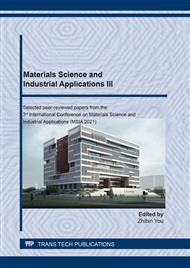p.73
p.78
p.84
p.91
p.101
p.108
p.114
p.120
p.129
Research on Thermal Inkjet Technology Based on CFD
Abstract:
In this paper, a thermal inkjet printing simulation model is established in the CFD simulation platform, and the influence of inkjet driver parameters and ink physical parameters on the printing process is studied by numerical simulation. The evaporation-condensation model is coupled with the VOF multiphase flow model in Fluent software to establish a thermal inkjet printing process simulation model. Based on the orthogonal test method, we investigate the influence of fluid physical parameters (ink viscosity, surface tension) and inkjet driver parameters (heater temperature value) on droplet formation by changing the physical parameters of the material and the boundary conditions of the model. Through the comparison of the results, exploring the adjustment rules of thermal inkjet technology and obtaining the optimal combination of material and process parameters for high-quality ink drop formation.
Info:
Periodical:
Pages:
101-107
Citation:
Online since:
May 2021
Authors:
Keywords:
Price:
Сopyright:
© 2021 Trans Tech Publications Ltd. All Rights Reserved
Share:
Citation:


